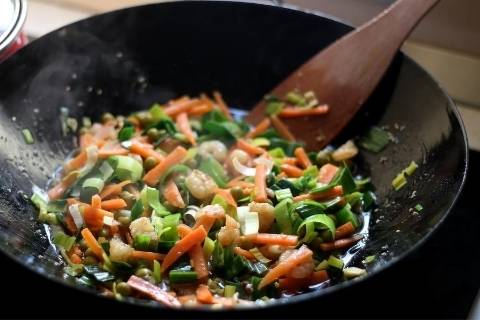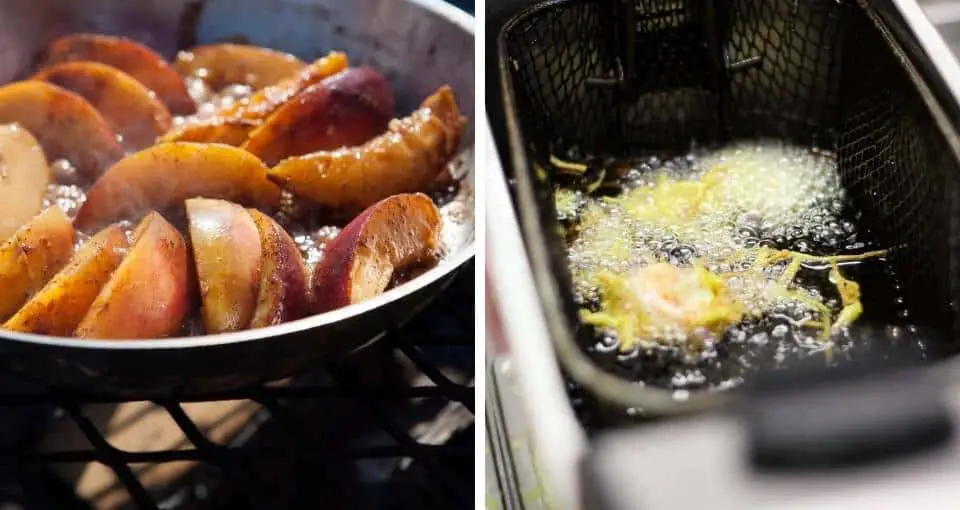I wanted to know if shallow frying foods in a pan is any bit healthier than deep frying. Especially in terms of added calories. The answer was complicated but once you understand you’ll be surprised.
Here is the best explanation for how many calories are added from the oils used to fry foods. We also get a better understanding of the two methods of frying foods and how each one differs.
The complicated food science behind frying foods makes it difficult to know how many calories are added from frying. But most studies show that whether you’re pan-frying or deep-frying, expect between 50 and 75 percent of total calories to come from fat.
Pan frying food adds less calories from the cooking oil than deep frying. Because not as much oil is needed. About 120 calories added per tablespoon of frying oil used. Then figure how much of that oil gets soaked up into the food compared to how much is left in the pan.
But is also really depends on oil absorption and how greasy or oily your food is after frying it.
Deep fried and pan fried food tastes really good. Why? Because the food science behind frying creates a crispy outside and tender inside due to the unique and intricate chemistry that takes place in frying.
Oil Absportion When Deep Frying
The reason food is crispy from deep frying is because the heat actual dehydrates the outside moisture. When done right deep fried food should not be oily or greasy.
It is only during the cooling off period that oil gets absorbed back into the food. Because during the actual frying process, the fast intense heat exposure causes moisture to escape. Preventing oil from being absorbed.
If you want less greasy food from deep frying then use a paper towel and pat dry and soak up any extra oil. Do this quickly after removing the food from the fryer but be careful not to get burned.
By soaking up excess oil you stop it from being absorbed into the food and adding additional calories.
How Many Calories In Cooking Oil
In order to help you understand how much calories you are adding to food when frying. You need to first know about many calories are in cooking oil. Especially by each serving.
Typically the serving size for most cooking oils is one tablespoon. With each serving there is between 119 – 124 calories depending on the oil. There isn’t much of a difference in the types of oils and the calories per serving.
Olive, palm kernel and peanut oil have the least of amount of calories per serving. Here is a chart showing how many calories per serving for each oil.
| Cooking Oil | Calories per Tablespoon |
| Palm Kernel Oil | 117 Calories |
| Olive Oil | 119 calories |
| Peanut Oil | 119 calories |
| Soybean Oil | 120 Calories |
| Sunflower Oil | 120 Calories |
| Palm Oil | 120 Calories |
| Coconut Oil | 121 Calories |
| Canola Oil | 124 Calories |
| Avocado Oil | 124 Calories |
Cooking oils have a lot of calories due to their high fat content. I would say when frying with these oils, that no more than one tablespoon is added to the food. Depending of course on how much food you are frying and the type of food.
Still that is a lot of added calories just from frying foods. Since a lot of the oil is going to stay on the outside of the food, some will be absorbed. But when deep frying the oil isn’t suppose to inside the food.
This is also why trying to figure out how many calories deep frying and pan frying adds to your food is not an easy task and there is no quick and easy answer except – yes, it does add some fat and therefore calories to your overall meal. But does one add less calories than another? The answer isn’t so easy, here’s why:

Oil Frying is a Complicated Food Science Process
The food science of frying is a pretty remarkable thing. The high temperature oil dehydrates the outside of the food causing a change in the food’s chemistry – breaking down proteins, gelatinizing starches, caramelizing sugars via the Maillard reaction, and steaming the inner portion of the food.
When you deep fry, the oil must be up to 400 degrees Fahrenheit and the food must be completely submerged in oil. This is why deep fried food has a crispy outside – the high heat dehydrates the outside, and steams the inside of the food.
When you pan fry, the oil will get up to around 350 degrees Fahrenheit. This is why pan-fried food is not as crispy as deep fried food, but still has a desirable flavor and texture.
Here are the healthiest oils to deep fry with.
If you’re simply sauteing food in a pan it’s easy to estimate the amount of oil you’re adding to the food. Just measure out the amount of oil you added to the pan, and that’s how much fat you’ve added to the meal itself.
The Many Variables of Food Frying
One study showed that 50-75 percent of calories in fried food come from added fat during frying. However, that number can range depending on all of the following variables:
- Type of food/characteristics of the food
- Type of frying oil used
- Surface/volume ratio of oil
- How much air gets incorporated into the oil
- Frying temperatures
- How long the food fries for
- Material of the pan/container the food is being fried in
If we want to know the difference in calories-added to a battered fish in a deep fryer vs. a pan fry, it will likely be similar. The reason being is pan frying is essentially doing the same thing as deep frying, just not all at once.

The more important variables are things like what is being fried, and type of batter (if any). For example, a piece of chicken with excess batter is going to take on more oil in frying than a piece of chicken with light frying. This is because there is more surface area for the oil to cling onto.
In addition, the water content of the food that is being fried is very telling in how much oil will be added during the frying process. The water loss in the food is proportional to the amount of oil the food takes on3. So, if you’re frying a food with a higher water content (like a vegetable), it’s likely to take on more oil in the frying process.
The Only Way To Know is Food Calorimetry
It’s important to note that the most accurate way to determine just how much calories from fat frying (whether it’s deep-frying or pan-frying) is to use a food calorimeter 1.
A food calorimeter is a machine that determines how much heat is lost, and therefore how many calories are in the food. If you were to try and determine the calories added from frying a piece of chicken, you’d have to run a piece of chicken through it without frying and one after frying, and compare the change in calories.
But since a food-grade calorimeter is not an average kitchen tool, it’s best to assume deep frying and pan frying both can take on a healthy amount of fat (anywhere between 50-75 percent of total calories).

